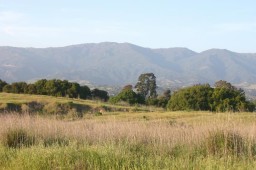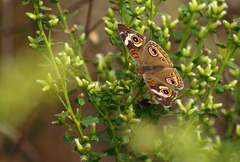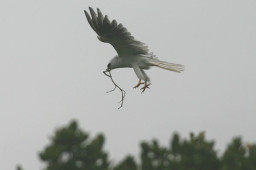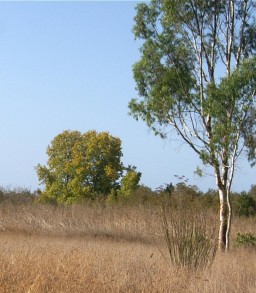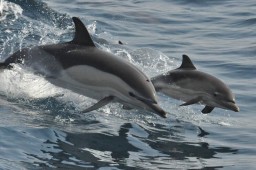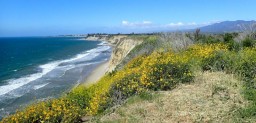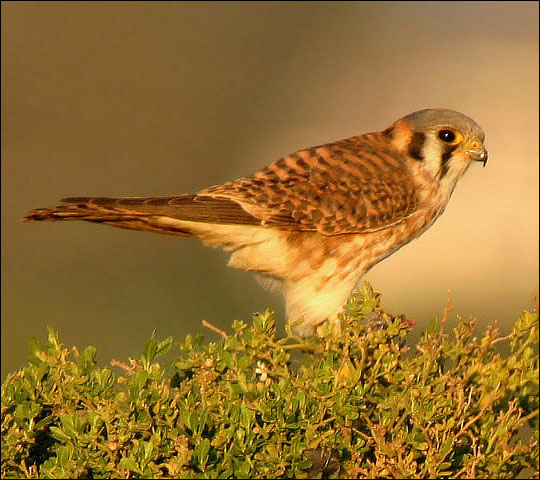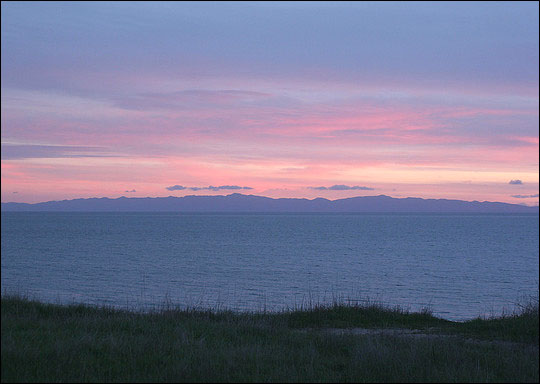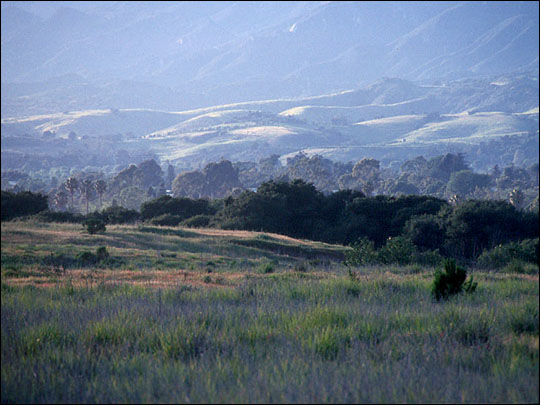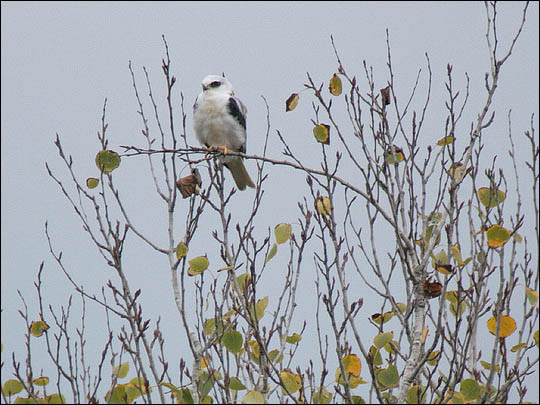The Most Wonderful Treasure….
As the end of the Lockdown approaches, I have been musing about how to “wrap up” our Treasure Hunts. How does one describe the entirety of the treasures of More Mesa … those few that I wrote about, and the hundreds of others that exist in this magical and remarkable place. Indeed, the most wonderful treasure on the whole South Coast is More Mesa itself!
What were our Treasure Hunts about? Over the past months, we discovered many of the individual treasures of More Mesa. We did this in fun looks at its trees, plants, birds, Insects, arachnids, reptiles, animals and even some man-made stuff. We reported on treasures that are native to our area, and even some that were imported here for various reasons and have since become difficult-to-control nightmares.
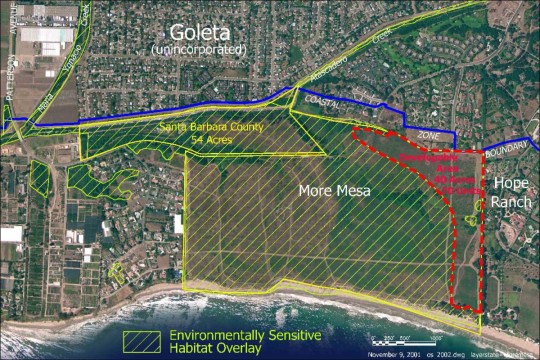 All of these treasures make their homes in one or more of the habitats of More Mesa. So … what’s the big deal? The big deal is that 80% of More Mesa has been identified as Environmentally Sensitive Habitat or ESH. ESH is the designation for a special place where plant and animal life, or their habitats, are rare or extremely valuable because of their special role in an ecosystem; one which could be easily disturbed or degraded … by us!
All of these treasures make their homes in one or more of the habitats of More Mesa. So … what’s the big deal? The big deal is that 80% of More Mesa has been identified as Environmentally Sensitive Habitat or ESH. ESH is the designation for a special place where plant and animal life, or their habitats, are rare or extremely valuable because of their special role in an ecosystem; one which could be easily disturbed or degraded … by us!
Now comes a really big AHA … More Mesa is extraordinary in that it contains five different, distinct and unique habitat types … more than any other open space on the South Coast! It begins with a distinct vegetation community created by differences in topography, soil types, sun exposure and moisture. Then each plant community, in its turn, determines the types of wildlife that will be present. Thus, three important factors, physical features, vegetation and wildlife, create a unique habitat. With that background in mind, we can explore where all the treasures we talked about for the past 15 months make their homes within their special habitats.
Trees Crave Lots of Water: We talked about four species of trees; Willows, Cottonwoods, Sycamores and Oaks. All these trees need water, and we typically find the first three somewhere very near water. Their habitat, Riparian Woodlands can be found on More Mesa near Atascadero Creek and its adjacent flood plains as well as canyons and ravines.
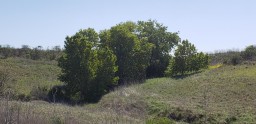
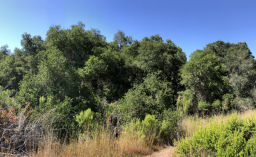 Oaks need water as well, but are well adapted by having an extremely long tap root that eventually finds water … somewhere. Oaks have their own special habitat which is called, appropriately enough, Oak Woodland. For me, having been a climber in my youth, this beautiful habitat is hauntingly reminiscent of the forests in the foothills of the Sierras.
Oaks need water as well, but are well adapted by having an extremely long tap root that eventually finds water … somewhere. Oaks have their own special habitat which is called, appropriately enough, Oak Woodland. For me, having been a climber in my youth, this beautiful habitat is hauntingly reminiscent of the forests in the foothills of the Sierras.
More Mesa’s Plants Live in all Habitats: Our plant Treasure Hunts had us looking for plants that live in soil, wet soil and water as well. We searched for Miner’s Lettuce, Elderberries, Datura and various water plants. We even devoted a whole issue to dreaded invasive plants; species brought to the Goleta Valley as cash crops, good feed for cattle or just by accident!
The Miner’s Lettuce we looked at in Spring likes the shade of an Oak Woodland, while Elderberry prefers a little water in its life and does well in Riparian Woodlands. Datura seemed to thrive in almost all habitats.
Vernal Pool 2002
 Our issue on water plants looked at plants that populate Wetlands … like Atascadero Creek and its adjacent marshes, canyon and ravine bottoms, meadows and open water pools.
Our issue on water plants looked at plants that populate Wetlands … like Atascadero Creek and its adjacent marshes, canyon and ravine bottoms, meadows and open water pools.
However, the most remarkable Wetland we have on More Mesa is a Vernal Pool on the southeast corner. These very special and fast disappearing wetlands, are seasonal pools that fill with winter rainwater, and then dry out gradually thru the Spring and early Summer. Vernal Pools support a variety of rare water plants. Our own Vernal Pool was studied extensively the last time it filled, in Spring of 2019, and was subsequently identified as the most prolific Vernal Pool in all of the Goleta Valley. To learn more about Vernal Pools, and why the ones that remain are so very important, read about these unusual wetlands on our website.
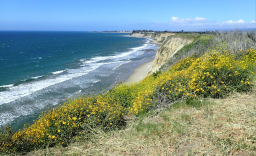 The Coast Has a Special Habitat All its Own: As one strolls along the coast at the southern edge of More Mesa, you are likely to discover Deerweed, an extremely interesting plant we talked about when we wrote about bees. Remember how bees can see in the ultraviolet? This coastal path is also likely to give the visitor a good look at a Western Fence Lizard and perhaps a lone, impressive, and completely harmless, large Gopher Snake. A look skyward over the ocean might also include a Western Gull hunting for a sea food dinner.
The Coast Has a Special Habitat All its Own: As one strolls along the coast at the southern edge of More Mesa, you are likely to discover Deerweed, an extremely interesting plant we talked about when we wrote about bees. Remember how bees can see in the ultraviolet? This coastal path is also likely to give the visitor a good look at a Western Fence Lizard and perhaps a lone, impressive, and completely harmless, large Gopher Snake. A look skyward over the ocean might also include a Western Gull hunting for a sea food dinner.
The coastal walk, includes all of the fourth habitat on More Mesa, Coastal Bluff Scrub, a habitat that, when we are fortunate enough to get enough rain, offers us a spectacular late winter show. The star of this show is the California Brittle Bush, with its cast of hundreds of thousands of yellow blossoms decorating the top of the cliff and many feet below as well.
Mostly It’s Grass: The last habitat on More Mesa is also the largest … Grasslands … a habitat that can be found throughout level mesa areas and on some canyon slopes.
In the mid 1800s, when More Mesa was occupied by grazing cattle, grass was really important. And while More Mesa is no longer home to even a single cow, grasslands continue to play a critical ecosystem role. First, Grasslands are home to myriad species of small birds who eat seeds. And of vital importance, seeds and grasses provide food for small mammal populations … think Voles, Mice, Gophers, Rabbits and Squirrels. And you might remember the progression we talked about in earlier issues, wherein grass seeds provide food for small mammals and then small mammals serve as food for sensitive raptors as well as larger mammals. In other words, Grasslands are the cafeteria for almost all birds and many mammals.However, while small birds also make their homes in the Grasslands, raptors only use it as a cafeteria and generally live in other habitats … habitats with trees.
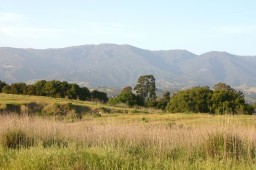
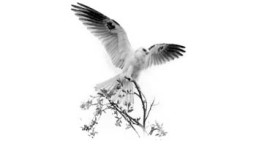
For example, and of major importance, in seasons with adequate rainfall, More Mesa can become home for up to 4 nesting pairs of our famous signature bird, the White-tailed Kite. Remarkably, in this year of extremely low rainfall, we have two adult pairs that are, even as I write this, feeding 6 hungry offspring!
We also looked at other birds in our Treasure Hunts, among them Great Blue Herons, Owls and Roadrunners. All of these, as well as the Kites, find food in the Grasslands of More Mesa, with the Roadrunner living there as well. Even the Peregrine Falcon, preferring birds for breakfast and dinner finds sustenance from the smaller birds that make their homes in the grasslands of More Mesa.
What about those larger mammals? We often have sightings of Bobcats, medium sized cats that feed on smaller mammals found on More Mesa. And, on another remarkable front, two Mountain Lions were spotted on the northwest part of More Mesa this year!
Big and tiny … our Treasure Hunts also looked at the Butterflies and Spiders found all over More Mesa’s Grasslands. And finally, the “man made stuff”, was a look at an important chapter in our country’s history and a fun departure from our usual hunts.
More Mesa is Part of a Bigger Picture: Habitats aside, it is important to remember that the canyons and ravines of More Mesa are linked to Atascadero Creek and larger regional ecosystems; systems providing wildlife migration corridors that reach all the way from the foothills to the shore.
Walking on More Mesa is a voyage back more than two centuries. Saving it preserves an important look at what was, all that we have lost and what we still can save. It is the last great place in Santa Barbara.

It has been an honor and a privilege to explore the treasures of More Mesa with you during this difficult and tumultuous time. Thank you for letting me come into your homes to share the wonder of this beautiful, magical piece of our history.
Look for more traditional news updates about More Mesa in the upcoming months and, most of all, thank you for reading the Treasure Hunts and thank you for caring about More Mesa … Valerie

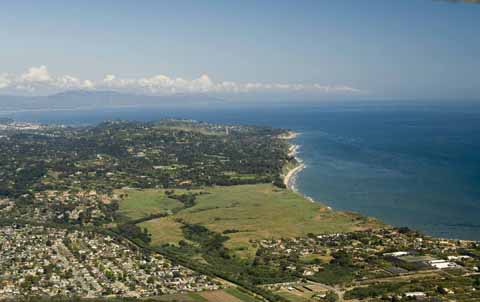

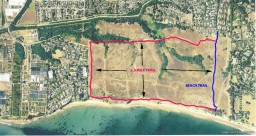
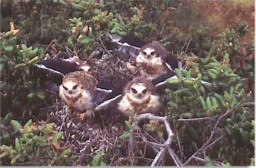
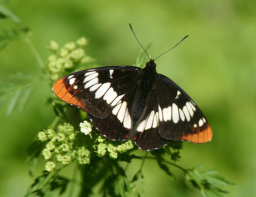
 So what did happen in June 1859? According to Tompkins, it was about 80 F by noon on that fateful day… a little high for our lovely Goleta Valley … known for its moderate temperatures. Then, about 1 PM according to Tompkins, a ‘blast of superheated air’ came from the direction of Santa Ynez Peak and hit the Goleta Valley, alarming the residents and sending them scurrying for cover inside thick-walled buildings. Tompkins wrote that by 2 PM the temperature had reached an incredible 133 F, with the northwest wind bringing ‘great clouds of impalpable dust’. People reportedly took refuge in several places including behind the 3-foot-thick walls of the Daniel Hill adobe. Calves, rabbits, and cattle died on their feet according to a “government report”, and fruit fell from trees to the ground, scorched on the windward side. Birds fell dead from the sky and others flew into wells in search of cooler air and drowned. About 5 PM the searing, hot wind died down, the report said, the thermometer ‘cooled off’ to 122 F.
So what did happen in June 1859? According to Tompkins, it was about 80 F by noon on that fateful day… a little high for our lovely Goleta Valley … known for its moderate temperatures. Then, about 1 PM according to Tompkins, a ‘blast of superheated air’ came from the direction of Santa Ynez Peak and hit the Goleta Valley, alarming the residents and sending them scurrying for cover inside thick-walled buildings. Tompkins wrote that by 2 PM the temperature had reached an incredible 133 F, with the northwest wind bringing ‘great clouds of impalpable dust’. People reportedly took refuge in several places including behind the 3-foot-thick walls of the Daniel Hill adobe. Calves, rabbits, and cattle died on their feet according to a “government report”, and fruit fell from trees to the ground, scorched on the windward side. Birds fell dead from the sky and others flew into wells in search of cooler air and drowned. About 5 PM the searing, hot wind died down, the report said, the thermometer ‘cooled off’ to 122 F.